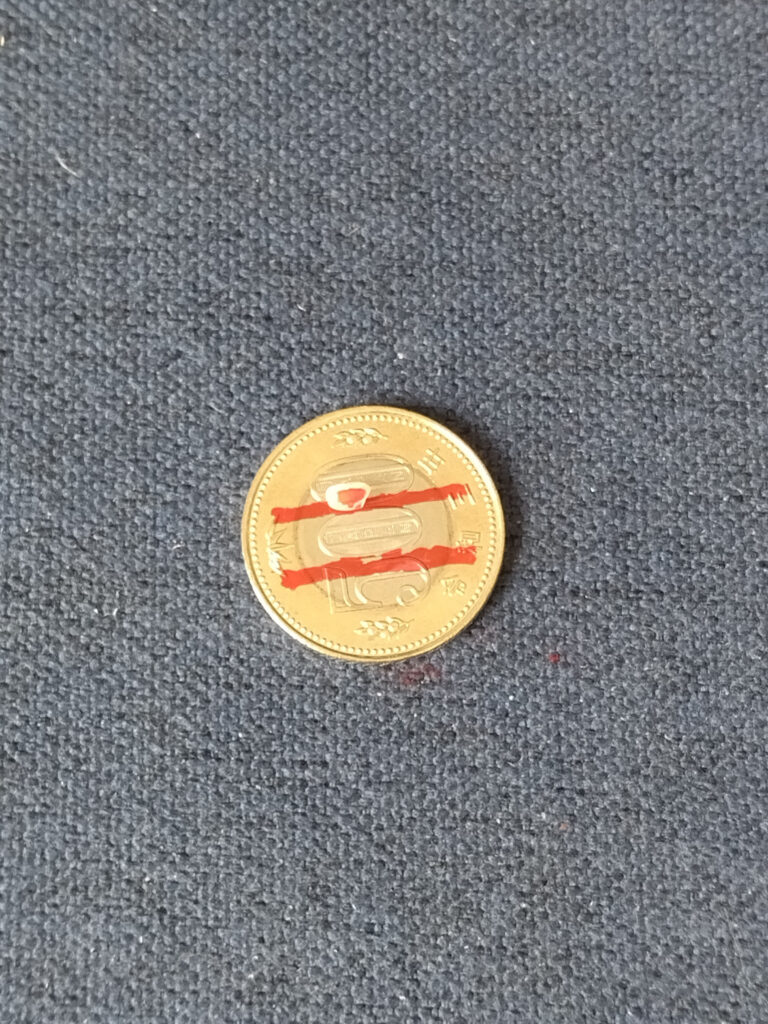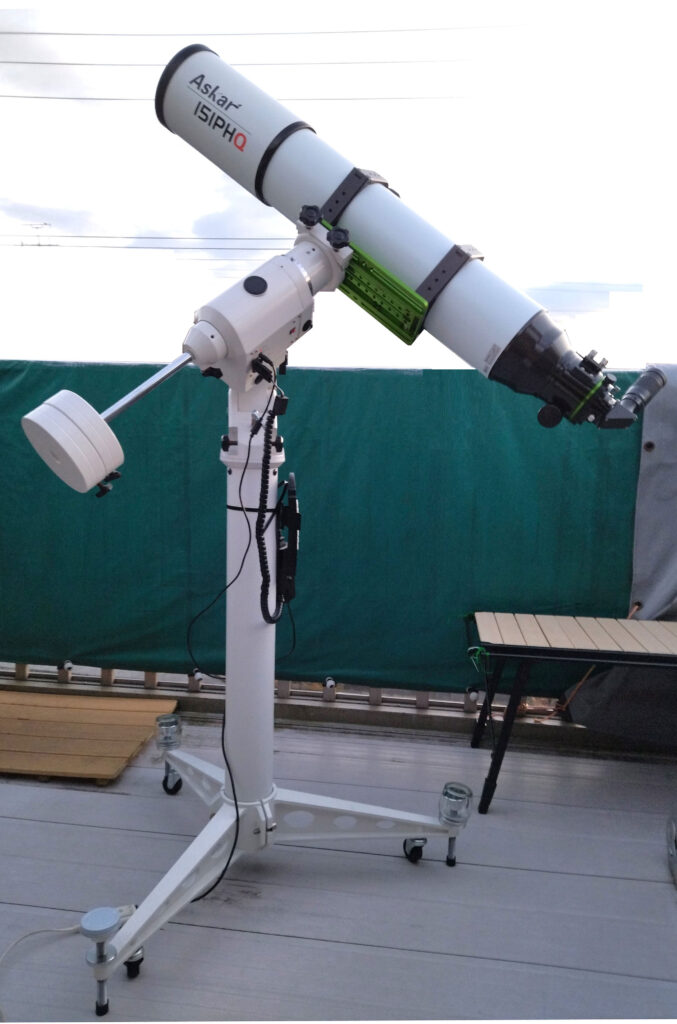Masa’s monologue (Why I bought a new telescope)
私の姉は,スイスのアルプスに行って,天候等でなかなかその雄姿が拝めないマッターホルンを,幸運にも見ることができたので,ことあるごとに自慢をします.私の弟は,やはりマッターホルンに行ったものの,最初は残念ながら天候に恵まれず悔しい思いをしたので,翌年、もう一度スイスに出かけ,今度は,マッターホルンの麓のホテルに4連泊してその雄姿を眺め,朝焼けに染まる赤いマッターホルンも見てきたと自慢します.私はその話を聞いて,「あっ,それなら,ある番組で,スイスの氷河特急や登山鉄道,そしてマッターホルンの近景や赤焼けまで,テレビで見て十分楽しんだよ」と言い終わるか終わらないうちに,二人から,「何言ってんの,そんなん,マッターホルンは,直接,自分の目で見なけりゃ価値は全くない(わ)よ」と言われて忸怩たる思いをしました.私は隠居の身なので時間はいくらでもあるし,貯金も多少はあるので,ヨーロッパのアルプスを旅することくらいはできますが,それでマッターホルンを見ることができたとしても,「何ぼ,のものかなあ」と考えてしまいます.そこで,ヨーロッパアルプスよりももっと遠くまで出かけて,人があまり直接見たことがないものを見てこようと思いました.「そうだ,木星まで出かけて行って,大赤斑をこの目で直接見てこよう」と考え,JALやANAに,木星行きのロケットの出発時刻を尋ねたのですが,残念ながら,いろいろなトラブル続きで木星行きのロケットは,20年以上遅延するとのことでした.そんなのを待っていたら,私の寿命が尽きてしまうではないですか.仕方がないので,自宅2階の窓から,天体観測用のバルコニーに出て,そこに設置した望遠鏡を木星に向けて,大赤斑を直接自分の目で眺めることにしました.これなら,木星の大赤斑がこちらを向くたびに(木星は10時間かけて自転しているので,いつでも大赤斑が見れるとは限らない),何度でも,木星に出かけて行って自分の目で大赤斑を確かめることができます.ただ,アマチュアの天体望遠鏡で木星を見ても,木星自体は,例えば,下記「Conceptual Photo (概念写真)」に示すように,500円玉に茶色の二本の平行線を引いた感じに見えるだけで,また,大赤斑は,片方の線上を米粒が動いて行くように見えるに過ぎません.ネットを検索すれば,もっと鮮やかな木星や大赤斑の画像をいくらでも手に入れることができますが,それとは雲泥の差です.しかし,小型の天体望遠鏡を使ってでも,時々刻々変化する木星の姿を,直接,自分の目で見ることが貴重で大切なのです.もちろん,いやしくも木星の大赤斑を見てきたと自慢するためには,アマチュア用にしても優れて安定した望遠鏡が必要ですし,またその観測には,十分鍛えた「人の目」が肝要になります.さらに,大気の安定と天候の良いことは大前提です.私の天体観望のキャリアは50年以上になりますが,仕事に就いているときは,年に1回,望遠鏡を出すか出さないかの程度で,お世辞にも天文マニアとは言えません.しかし幸い,退職してからは,自宅の2階にバルコニーを作って,好きな時に天体観測ができるようにしてあり,惑星の眼視にも多少慣れてはきました.あとは,最近注目されている4枚玉アポクロマート屈折望遠鏡を入手して観測したいと考え,今回,直径151mmの Askar’151PHQ を購入したわけです.
さて,それほど性能の良い天体望遠鏡だったなら,「眼視」ではなく,天体撮影による観測が相応しいのではないかと思われる方もいるでしょう.最近は高感度のCCDカメラやそこから得られた記録データを素早く積算処理できる高度なソフトウェアも容易に利用できて,暗い外で寒い思いをしなくても,温かい部屋の中から望遠鏡を遠隔操作して,眼視では決して得られないような素晴らしい画像をPC上で簡単に手にできる時代になっています.もちろん,その方法も「眼視」と並行して進めていきたいと考えます.しかし,最初に述べたマッターホルンの例と同じで,スイスへ出かけて実際に山を目にするのと,遠く離れた日本でお茶を飲みながらテレビを見るのとでは一緒になりません.寒い外で震えながら,瞬きを繰り返して500円玉の上を進む米粒状の大赤斑を観測する.この醍醐味は,技術がどんなに進歩しても,なかなか捨てられないのではないかと思います.
(追記)
マッチ売りの少女(アンデルセン作)は,凍える夜空の下で最後のマッチを灯したあと,死んで天国に召されてしまいます.しかし私の場合,観測を終えたのちは,熱い風呂に入り,暖かい布団で眠ることができます.まあ,最後,天国に行けるかどうかは大変疑問ですが.可哀そうなあの少女は寒い街角で明るく光る木星を眺めていたでしょうか.


My sister went to the Swiss Alps and was lucky enough to see the Matterhorn, which is rarely seen due to weather conditions, and she brags about it every chance she gets. My younger brother also went to the Matterhorn, but was disappointed at first because the weather was not good, so the following year he went to Switzerland again, and this time he stayed in a hotel at the foot of the Matterhorn for four nights in a row, enjoying the majestic sight and seeing the Matterhorn dyed red by the morning glow. When I heard that story, I had barely finished saying, “Oh, then, I enjoyed watching a program on TV that showed the Swiss Glacier Express and mountain railways, as well as a close-up view of the Matterhorn and its red glow,” when they said to me, “What are you talking about? The Matterhorn is not worth seeing at all unless you see it with your own eyes.” I felt embarrassed. I’m retired, so I have plenty of time and some savings, so I can travel to the European Alps, but even if I could see the Matterhorn, I would think, “What’s the point?” So I thought I would go further than the European Alps and see something that not many people have seen directly. “Yes, I’ll go to Jupiter and see the Great Red Spot with my own eyes,” I thought, and asked JAL and ANA about the departure time of the rocket to Jupiter, but unfortunately, due to various troubles, the rocket to Jupiter will be delayed for more than 20 years. If I waited that long, my life would be over. Since there was no other way, I decided to go out to the balcony for astronomical observation from the window of my second floor house, point the telescope I had set up there at Jupiter, and see the Great Red Spot with my own eyes. That way, whenever the Great Red Spot of Jupiter turns towards me (Jupiter takes 10 hours to rotate on its axis, so it is not always possible to see the Great Red Spot), I can go to Jupiter and see it with my own eyes as many times as I want. However, even if you look at Jupiter through an amateur telescope, Jupiter itself will look like a 500-yen coin with two parallel brown lines drawn on it, as shown in the “Conceptual Photo,” and the Great Red Spot will look like nothing more than a grain of rice moving along one of the lines. You can search the Internet to find more vivid images of Jupiter and the Great Red Spot, but this is a world apart. However, even if you use a small telescope, it is valuable and important to see the ever-changing appearance of Jupiter directly with your own eyes. Of course, to be able to boast that you have seen Jupiter’s Great Red Spot, you need a good and stable telescope, even for amateur use, and well-trained “human eyes” are essential for the observation. Furthermore, a stable atmosphere and good weather are essential. I have been observing the stars for more than 50 years, but when I was working, I only took out my telescope once a year, if that. I can’t even call myself an astronomy fanatic. However, fortunately, after I retired, I built a balcony on the second floor of my house so that I can observe the stars whenever I want, and I have become somewhat accustomed to visually observing the planets. And next, I thought I’d get a four-element apochromatic refracting telescope, which has been attracting attention recently, and so I purchased the Askar’151PHQ, which has a diameter of 151 mm.
Now, some may think that if it is such a high-performance telescope, it is more appropriate to observe the celestial bodies by photographing them, rather than by visual observation. Recently, it has become easy to use high-sensitivity CCD cameras and advanced software that can quickly accumulate and process the recorded data obtained from them, and we can now easily operate the telescope remotely from inside a warm room and obtain wonderful images on a PC that could never be obtained by visual observation, without having to suffer in the cold outside in the dark. Of course, we would like to continue to develop this method in parallel with visual observation. However, just like the example of the Matterhorn mentioned at the beginning, traveling to Switzerland to actually see the mountain is not the same as watching TV while drinking tea in faraway Japan. Shivering outside in the cold, I blink repeatedly as I watch the rice-grain-sized Great Red Spot move across the surface of a 500-yen coin. I think this thrill is something that will be hard to give up, no matter how much technology advances.
(Addendum)
The Little Match Girl (by Hans Christian Andersen) dies and goes to heaven after lighting the last match under the freezing night sky. However, in my case, after finishing my observations, I can take a hot bath and sleep in a warm futon. Well, although, I doubt whether I can go to heaven in the end. I wonder if the poor girl was gazing at the brightly shining Jupiter on a cold street corner.